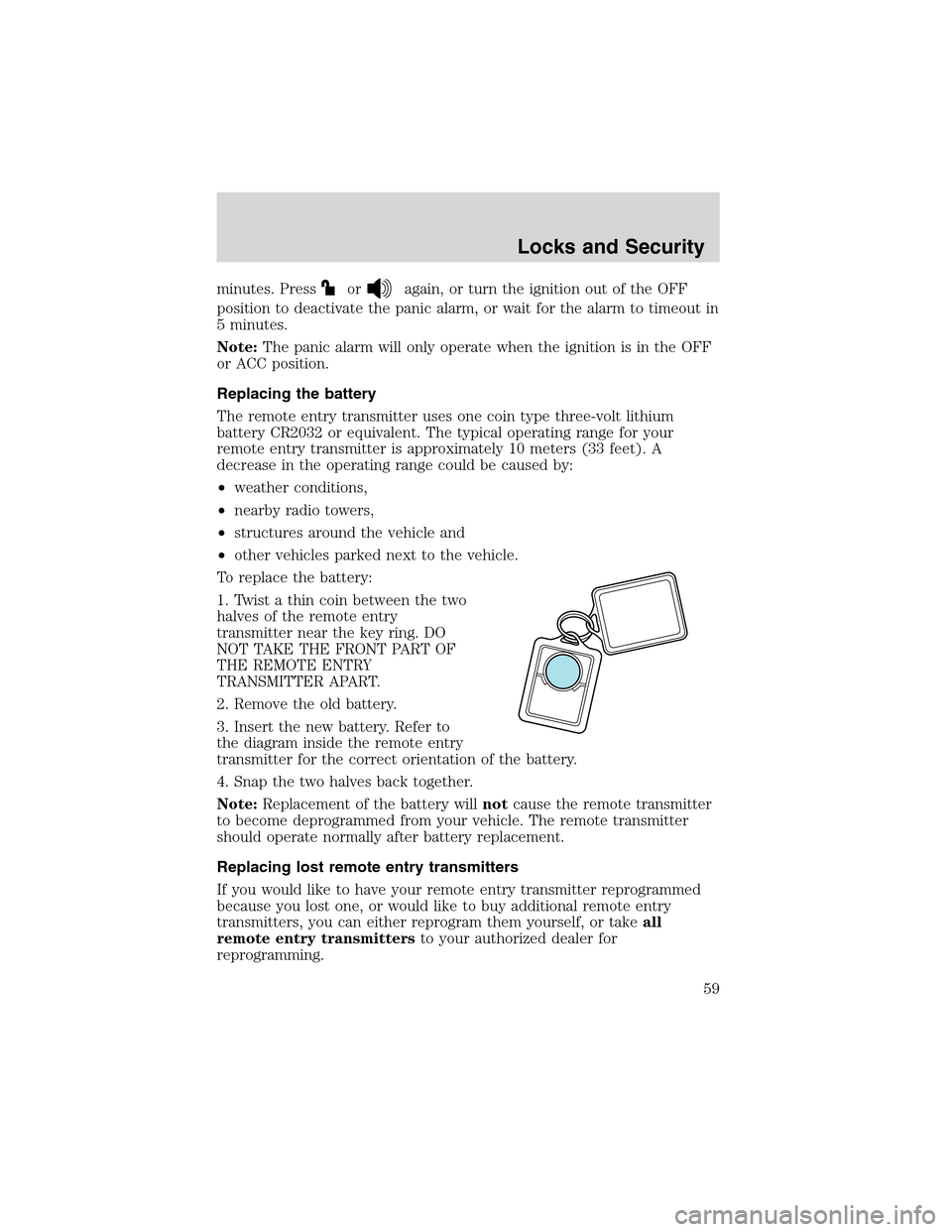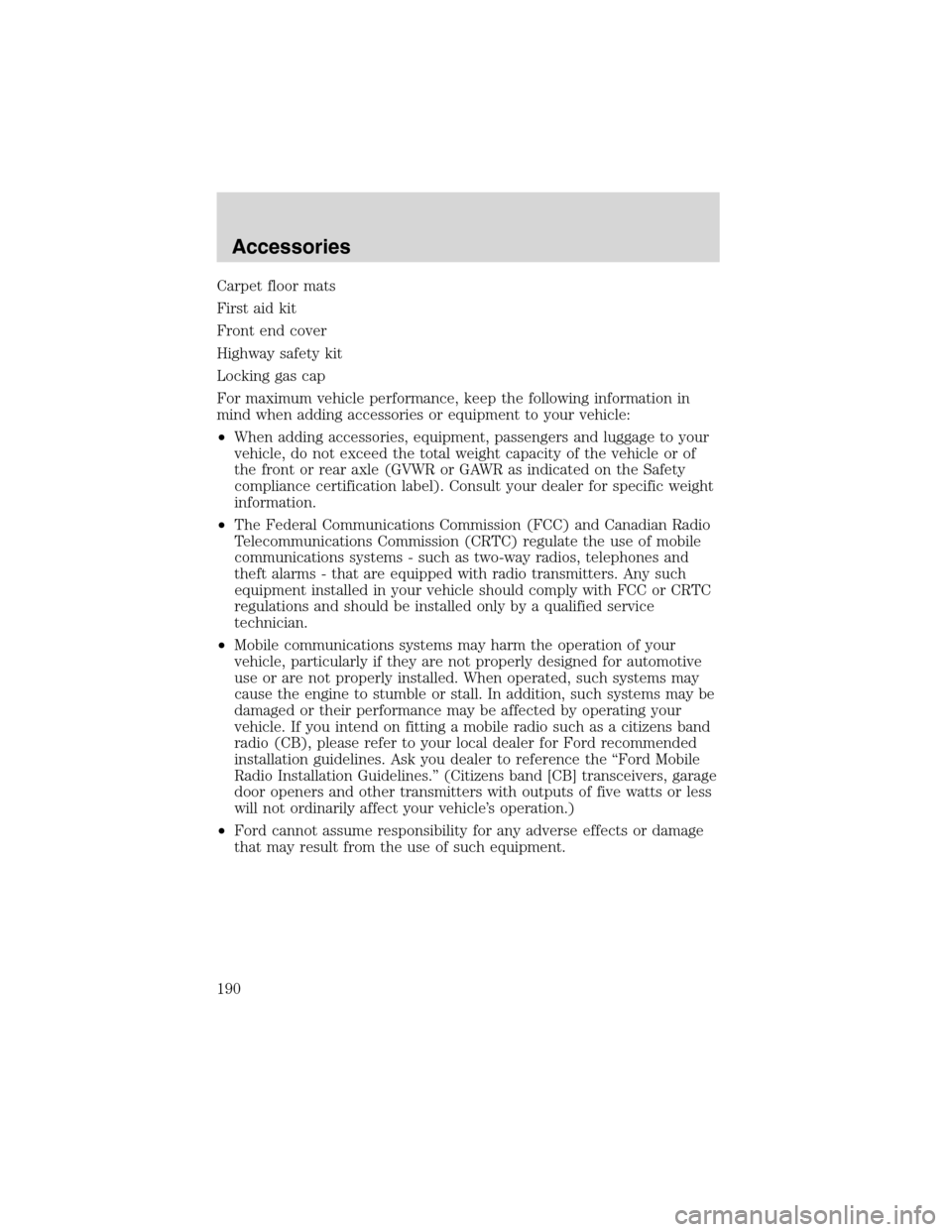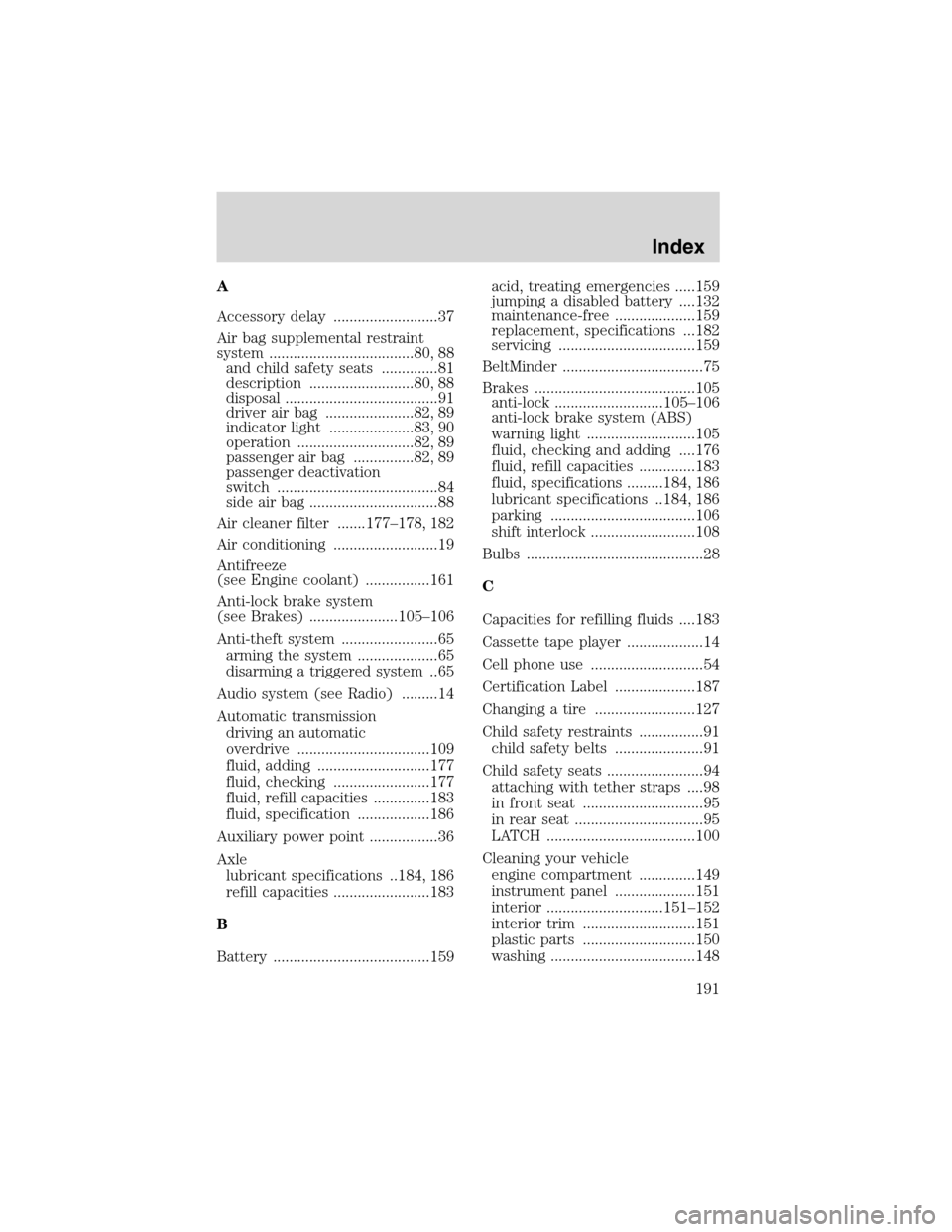2003 FORD THUNDERBIRD radio
[x] Cancel search: radioPage 59 of 200

minutes. Pressoragain, or turn the ignition out of the OFF
position to deactivate the panic alarm, or wait for the alarm to timeout in
5 minutes.
Note:The panic alarm will only operate when the ignition is in the OFF
or ACC position.
Replacing the battery
The remote entry transmitter uses one coin type three-volt lithium
battery CR2032 or equivalent. The typical operating range for your
remote entry transmitter is approximately 10 meters (33 feet). A
decrease in the operating range could be caused by:
•weather conditions,
•nearby radio towers,
•structures around the vehicle and
•other vehicles parked next to the vehicle.
To replace the battery:
1. Twist a thin coin between the two
halves of the remote entry
transmitter near the key ring. DO
NOT TAKE THE FRONT PART OF
THE REMOTE ENTRY
TRANSMITTER APART.
2. Remove the old battery.
3. Insert the new battery. Refer to
the diagram inside the remote entry
transmitter for the correct orientation of the battery.
4. Snap the two halves back together.
Note:Replacement of the battery willnotcause the remote transmitter
to become deprogrammed from your vehicle. The remote transmitter
should operate normally after battery replacement.
Replacing lost remote entry transmitters
If you would like to have your remote entry transmitter reprogrammed
because you lost one, or would like to buy additional remote entry
transmitters, you can either reprogram them yourself, or takeall
remote entry transmittersto your authorized dealer for
reprogramming.
Locks and Security
59
Page 102 of 200

STARTING
Positions of the ignition
1. LOCK, locks the gearshift lever
and allows key removal. (The
steering wheel will not lock after
key removal.)
2. OFF, shuts off the engine and all
accessories except the radio,
convertible top control and the
power windows if accessory delay is
active. This position also allows the
automatic transmission shift lever to be moved from the P (Park)
position without the brake pedal being depressed.
When the key is in the ignition OFF position, the automatic
transmission shift lever can be moved from the P (Park) position
without the brake pedal depressed. To avoid unwanted vehicle
movement, always set the parking brake.
3. ACCESSORY, allows the electrical accessories such as the radio to
operate while the engine is not running.
4. RUN, all electrical circuits operational. Warning lights illuminated. Key
position when driving.
5. START, cranks the engine. Release the key as soon as the engine
starts.
Preparing to start your vehicle
Engine starting is controlled by the powertrain control system. This
system meets all Canadian Interference-Causing Equipment standard
requirements regulating the impulse electrical field strength of radio
noise.
When starting a fuel-injected engine, don’t press the accelerator before
or during starting. Only use the accelerator when you have difficulty
starting the engine. For more information on starting the vehicle, refer to
Starting the enginein this chapter.
2
3
4
5
1
Driving
102
Page 120 of 200

The fuses are coded as follows.
Fuse/Relay
LocationFuse Amp
RatingPassenger Compartment Fuse
Panel Description
1 5A Starter relay coil
2 5A Radio start signal
3 5A ABS module
4 5A Cluster, PCM relay coil, Inertia
switch, Transmission park switch
5 5A Traction control switch, Speed
control brake switch
6 10A OBD II
7 5A PCM, RKE, Theft indicator
8 5A Right-hand turn/park/side marker
9 15A Right-hand headlamp
SEE
OWNER'S MANUAL
RELAY 1
REPLACEMENT
FUSES
FUSE 8FUSE 9FUSE 10FUSE 11FUSE 12FUSE 13FUSE 14FUSE 15FUSE 16FUSE 17FUSE 18FUSE 19FUSE 20FUSE 21
FUSE 1FUSE 2FUSE 3FUSE 4FUSE 5FUSE 6FUSE 7
FUSE 22FUSE 23FUSE 24FUSE 25FUSE 26FUSE 27FUSE 28FUSE 29FUSE 30FUSE 31FUSE 32FUSE 33FUSE 34FUSE 35
Roadside Emergencies
120
Page 121 of 200

Fuse/Relay
LocationFuse Amp
RatingPassenger Compartment Fuse
Panel Description
10 5A Left-hand turn/park/side marker
11 15A Left-hand headlamp
12 10A Passenger air bag on/off switch
13 5A Cluster
14 10A Air bag module
15 5A Not used (spare)
16 5A Not used (spare)
17 5A Cluster
18 20A Radio
19 20A Tilt/Tele motors
20 10A FEM, DATC, Cluster
21 10A Not used (spare)
22 10A Not used (spare)
23 10A Not used (spare)
24 5A Passive anti-theft transceiver
25 10A Not used (spare)
26 3A Windshield wiper relay
27 10A Radio
28 10A Not used (spare)
29 5A DATC
30 5A FEM
31 10A Map, Courtesy and Glove box
lamps
32 20A Cigar lighter
33 10A Dimmer control lamps
34 5A Outside mirrors
35 5A Stoplamp switch
Relay 1 — Not used
Roadside Emergencies
121
Page 160 of 200

Keep batteries out of reach of children. Batteries contain sulfuric
acid. Avoid contact with skin, eyes or clothing. Shield your eyes
when working near the battery to protect against possible splashing of
acid solution. In case of acid contact with skin or eyes, flush
immediately with water for a minimum of 15 minutes and get prompt
medical attention. If acid is swallowed, call a physician immediately.
Battery posts, terminals and related accessories contain lead and
lead compounds.Wash hands after handling.
Because your vehicle’s engine is electronically controlled by a computer,
some control conditions are maintained by power from the battery. When
the battery is disconnected or a new battery is installed, the engine must
relearn its idle and fuel trim strategy for optimum driveability and
performance. To begin this process:
1. With the vehicle at a complete stop, set the parking brake.
2. Put the gearshift in P (Park), turn off all accessories and start the
engine.
3. Run the engine until it reaches normal operating temperature.
4. Allow the engine to idle for at least one minute.
5. Turn the A/C on and allow the engine to idle for at least one minute.
6. Drive the vehicle to complete the relearning process.
•The vehicle may need to be driven to relearn the idle and fuel trim
strategy.
•If you do not allow the engine to relearn its idle trim, the idle
quality of your vehicle may be adversely affected until the idle
trim is eventually relearned.
When the battery is disconnected or a new battery installed, the
transmission must relearn its adaptive strategy. As a result of this, the
transmission may shift firmly. This operation is considered normal and
will not affect function or durability of the transmission. Over time the
adaptive learning process will fully update transmission operation to its
optimum shift feel.
If the battery has been disconnected or a new battery has been installed,
the short drop glass, clock and the preset radio stations must be reset
once the battery is reconnected.
Maintenance and Specifications
160
Page 190 of 200

Carpetfloor mats
First aid kit
Front end cover
Highway safety kit
Locking gas cap
For maximum vehicle performance, keep the following information in
mind when adding accessories or equipment to your vehicle:
•When adding accessories, equipment, passengers and luggage to your
vehicle, do not exceed the total weight capacity of the vehicle or of
the front or rear axle (GVWR or GAWR as indicated on the Safety
compliance certification label). Consult your dealer for specific weight
information.
•The Federal Communications Commission (FCC) and Canadian Radio
Telecommunications Commission (CRTC) regulate the use of mobile
communications systems - such as two-way radios, telephones and
theft alarms - that are equipped with radio transmitters. Any such
equipment installed in your vehicle should comply with FCC or CRTC
regulations and should be installed only by a qualified service
technician.
•Mobile communications systems may harm the operation of your
vehicle, particularly if they are not properly designed for automotive
use or are not properly installed. When operated, such systems may
cause the engine to stumble or stall. In addition, such systems may be
damaged or their performance may be affected by operating your
vehicle. If you intend on fitting a mobile radio such as a citizens band
radio (CB), please refer to your local dealer for Ford recommended
installation guidelines. Ask you dealer to reference the“Ford Mobile
Radio Installation Guidelines.”(Citizens band [CB] transceivers, garage
door openers and other transmitters with outputs of five watts or less
will not ordinarily affect your vehicle’s operation.)
•Ford cannot assume responsibility for any adverse effects or damage
that may result from the use of such equipment.
Accessories
190
Page 191 of 200

A
Accessorydelay..........................37
Air bag supplemental restraint
system ....................................80, 88
and child safety seats ..............81
description ..........................80, 88
disposal ......................................91
driver air bag ......................82, 89
indicator light .....................83, 90
operation .............................82, 89
passenger air bag ...............82, 89
passenger deactivation
switch ........................................84
side air bag ................................88
Air cleaner filter .......177–178, 182
Air conditioning ..........................19
Antifreeze
(see Engine coolant) ................161
Anti-lock brake system
(see Brakes) ......................105–106
Anti-theft system ........................65
arming the system ....................65
disarming a triggered system ..65
Audio system (see Radio) .........14
Automatic transmission
driving an automatic
overdrive .................................109
fluid, adding ............................177
fluid, checking ........................177
fluid, refill capacities ..............183
fluid, specification ..................186
Auxiliary power point .................36
Axle
lubricant specifications ..184, 186
refill capacities ........................183
B
Battery .......................................159acid, treating emergencies .....159
jumping a disabled battery ....132
maintenance-free ....................159
replacement, specifications ...182
servicing ..................................159
BeltMinder ...................................75
Brakes ........................................105
anti-lock ...........................105–106
anti-lock brake system (ABS)
warning light ...........................105
fluid, checking and adding ....176
fluid, refill capacities ..............183
fluid, specifications .........184, 186
lubricant specifications ..184, 186
parking ....................................106
shift interlock ..........................108
Bulbs ............................................28
C
Capacities for refilling fluids ....183
Cassette tape player ...................14
Cell phone use ............................54
Certification Label ....................187
Changing a tire .........................127
Child safety restraints ................91
child safety belts ......................91
Child safety seats ........................94
attaching with tether straps ....98
in front seat ..............................95
in rear seat ................................95
LATCH .....................................100
Cleaning your vehicle
engine compartment ..............149
instrument panel ....................151
interior .............................151–152
interior trim ............................151
plastic parts ............................150
washing ....................................148
Index
191
Page 194 of 200

K
Keylessentrysystem
autolock.....................................61
Keys
positions of the ignition .........102
L
Lamps
autolamp system .......................24
bulb replacement
specifications chart ..................28
cargo lamps ...............................26
daytime running light ...............25
headlamps .................................24
headlamps, flash to pass ..........25
instrument panel, dimming .....26
interior lamps .....................27, 29
replacing bulbs ....... 28–29, 31–34
Lane change indicator
(see Turn signal) ........................27
Lights, warning and indicator ......8
anti-lock brakes (ABS) ..........105
Load limits .................................114
GAWR ......................................114
GVWR ......................................114
trailer towing ..........................114
Locks
autolock .....................................61
doors ..........................................55
Lubricant specifications ...184, 186
Lug nuts, anti-theft ...................131
Lumbar support, seats ...............67
M
Manual transmission
fluid capacities ........................183
lubricant specifications ..........186Master lighting switch ................24
Mirrors .........................................38
side view mirrors (power) .......38
Motorcraft parts ................171, 182
O
Octane rating ............................170
Oil (see Engine oil) ..................156
P
Parking brake ............................106
Parts (see Motorcraft parts) ....182
Power distribution box
(see Fuses) .......................122, 125
Power door locks ........................55
Power point .................................36
Power steering ..................107–108
fluid, checking and adding ....176
fluid, refill capacity ................183
fluid, specifications .........184, 186
Power Windows ...........................37
R
Radio ............................................14
Rear window defroster ...............22
Relays ........................................118
Remote entry system .................58
illuminated entry ......................60
locking/unlocking doors ...........55
opening the trunk .....................58
Roadside assistance ..................116
S
Safety Belt Maintenance ............79
Index
194